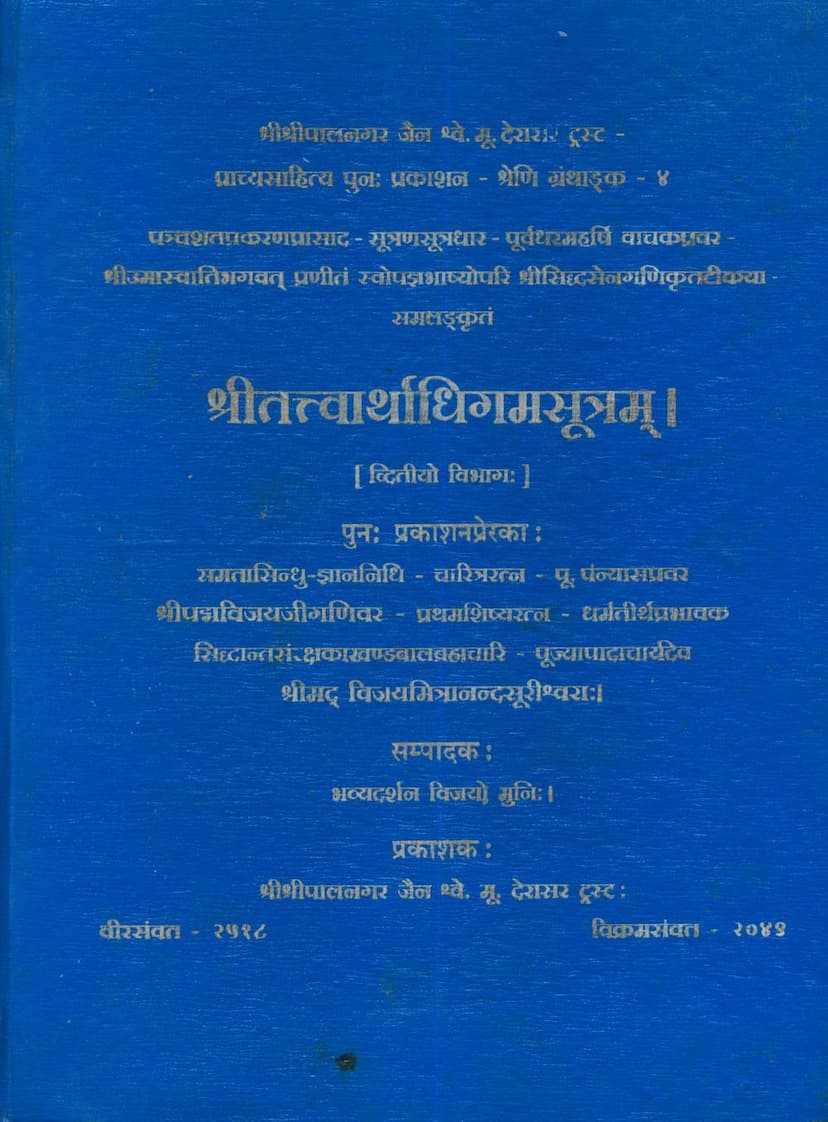Tattvarthadhigam Sutra Part 02
Added to library: September 2, 2025

Summary
The Tattvarthadhigama Sutra Part 02, authored by Bhavyadarshanvijay and published by Shripalnagar Jain S M Derasar Trust, is a profound Jain text that delves into the fundamental principles of Jainism, particularly focusing on the path to liberation (moksha). This second part of the Tattvarthadhigama Sutra builds upon the foundational concepts presented earlier, offering a detailed exposition of key Jain doctrines, with a particular emphasis on the "Āsrava" (influx of karma) and "Saṃvara" (cessation of influx) chapters, as well as the ultimate goal of "Moksha" (liberation).
Key Themes and Contents:
- Elucidation of Tattvas (Realities): The text elaborates on the seven tattvas (realities) or categories of existence in Jainism, providing further details and nuances to their understanding. This includes a deeper exploration of the nature of life (jiva), non-life (ajiva), influx of karma (asrava), bondage (bandha), cessation of influx (saṃvara), liberation (nirjara), and liberation itself (moksha).
- The Path to Liberation (Moksha Marga): A significant portion of the text is dedicated to outlining the "Moksha Marga" or the path to liberation, which is fundamentally described as Samyak Darshan (Right Faith), Samyak Gyan (Right Knowledge), and Samyak Charitra (Right Conduct). The text meticulously explains the components and practices necessary to cultivate these three jewels.
- Detailed Explanation of Asrava (Influx of Karma): The text provides an exhaustive analysis of the causes and processes through which karmic particles adhere to the soul. It details the various types of actions (karma), intentions, and activities that lead to this influx, emphasizing the role of passions (kashayas) like anger, pride, deceit, and greed, as well as sensory engagement and the subtle workings of the mind, speech, and body.
- The Practice of Saṃvara (Cessation of Karma): A crucial aspect of the text is the explanation of Saṃvara, the crucial process of stopping the influx of new karma. This is achieved through the practice of Right Conduct (Samyak Charitra), which includes the five vows (Mahavratas) for ascetics and the five vows (Anuvratas) for lay followers. The text likely details the ethical observances, restraints, and disciplines required to practice these vows effectively.
- The Role of Tapas (Austerities): The text highlights the importance of Tapas (austerities) as a means to purify the soul and achieve liberation. It likely categorizes and explains various forms of internal and external austerities that aid in shedding accumulated karma and preventing new influx.
- The Nature of Moksha (Liberation): The ultimate aim, Moksha, is described as the state of complete liberation from the cycle of birth and death, characterized by omniscience, infinite bliss, and the soul's natural pure state, free from all karmic coverings.
- Commentarial Tradition: The publication emphasizes that this particular version is based on the commentary (Tika) of Shri Siddhasen Ganini on the commentary (Bhashya) of Shri Umāsvāti Bhagvat, highlighting the rich tradition of scholarly interpretation within Jainism. The preface also mentions the inspiration for re-publication from revered Acharyas, indicating the text's significance and ongoing relevance.
- Historical and Scholarly Context: The publisher's note and the editor's remarks provide context about the re-publication effort, crediting individuals and trusts involved in preserving and disseminating Jain scriptures. It also touches upon the profound philosophical depth contained within Jain scriptures.
- Detailed Chapter Breakdown (Implied): Although the summary is based on the introductory and explanatory sections, the text itself likely follows a systematic structure, potentially covering topics like the nature of the soul, the different types of bodies, the states of spiritual development (Guna Sthanas), and the intricacies of karmic bondage and its cessation in detail. The mention of Chapter 6 and 7 in the text itself suggests a focus on Karma theory and the path to cessation.
In essence, Tattvarthadhigama Sutra Part 02 serves as a comprehensive guide for Jain practitioners seeking to understand the mechanics of karma, the methods for its cessation, and ultimately, the realization of liberation. It emphasizes the practical application of ethical principles, austerities, and spiritual knowledge as the means to purify the soul and attain the highest spiritual state. The commentary by Siddhasen Ganini further enriches the understanding of Umāsvāti's original work, making it accessible and deeply informative for serious students of Jain philosophy.